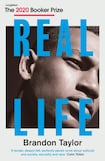
When the Booker longlist dropped a couple weeks ago it was met with a thunderous cacophony of puffs and groans. Nearly half of the 13 books (a Booker’s dozen, if you’re cringe) were written by Yanks. Now, I’m always front of the queue when it comes to dunking on the Yanks, but even I have to admit their track record in the Booker has been pretty phenomenal. To even further refute the criticism of their inclusion, we have the existence of Brandon Taylor and his novel Real Life, a book that is unquestionably the queer novel of the year.
Real Life may be Taylor’s debut but he is something of a veteran in online literary circles. The grande dame of literary Twitter, Taylor is well-known for his blistering (but always considered) literary hot takes, his adulation of Mavis Gallant, his bloody conquest against first-person narratives, and his penchant for all things knitwear. All of this, I believe, makes Taylor the first Extremely Online writer to make it on to the Booker longlist, a feat I am proclaiming as representation.
Wallace is a gay, black postgraduate student, born and raised in Alabama, now attending a Midwestern university, where he studies biochemistry. He is not only the single black person in his course but the first black person the course has seen in more than three decades. When we first meet Wallace it is the beginning of the weekend that will span the novel, and he is trepidatiously on his way to meet up with his friends at the pier.
For Wallace this social interaction is more of a task than a pleasure; he thinks how easy it would be for him to turn back and go home. From the first few pages we are made aware of Wallace’s disposition: he is meek and anxious, someone who prefers to observe conversations rather than partake in them. If someone makes a sudden movement, he flinches. He doesn’t share the news that his father died, because he knows what a fuss that will make. Wallace often reads like a modern-day Meursault, or someone from Gide. As the novel unfolds, more and more light is shed upon Wallace, revealing a tragic portrait, each brush stroke a thick impasto of abuse, racism and trauma.
However, Real Life is more than a harrowing scroll of despondency. It is also very much a classic campus novel. You have all the Tarttian trivialities of dinner parties and rounds of tennis and sailing on the lake, scenes of domesticity in which Taylor truly revels. For the first time in my life I was actually enticed by tennis, which is a sentence I’ll be devastated if Daunt does not use as the pull quote. By exploiting the set-pieces of the genre, Taylor exposes a side of the university complex that many pretend not to see, that despite often being portrayed as a great bacchanal of free politics and expression, university campuses can be incredibly oppressive environments for anybody who doesn’t fit within the specific template of white, male and cis.
No fantasy land
Real Life also stands out in the pantheon of recent queer fiction. Call Me By Your Name has been the most influential queer novel of this century for many reasons, not least because of André Aciman’s decision to set the novel inside a prelapsarian fantasy land. Queer characters in this land are free from the ills and oppressions of society, and thus queer stories are able to flourish because, for once, the characters can be happy. Think of the characters in Tomasz Jedrowski’s Swimming in the Dark who escape on a camping trip and enter their prelapsarian fantasy land within communist Poland; or Céline Sciamma’s Portrait of a Lady on Fire, which pushes the fantasy land to the extreme and takes place entirely on an island in the sea. Taylor absolutely refutes this trope. When he introduces the central plot line of the novel – that Wallace becomes the object of attraction to an allegedly het man – there is no convenient escape for them. Their “love” story is messy and complicated and awkward. After they first hook up there is no beautiful, poetic epiphany. The white cotton curtains of the bedroom don’t catch the moonlight as the night breeze caresses their naked bodies and Maria Callas spills tinnily from the gramophone. Instead, Wallace chugs water until he gets sick and leaves.
In Real Life, Taylor proves himself to be an effortless documenter of the domestic. It is a delight to read Taylor in full flow – his characters ricocheting off each other at a dinner party or simply when he is describing someone cooking fish in the middle of the night. Through Wallace, he has created a great tragic protagonist, a character sure to resonate with many as he makes his way through a world that was never made for him. All of this makes Real Life an essential novel from a truly exciting new writer.












